|
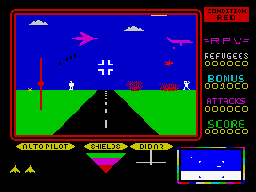
 100 - Zzoom
(Imagine) 100 - Zzoom
(Imagine)
This was probably the first Speccy game
designed with sadists in mind. In itself it was a zappy and
challenging shoot-'em-up, but the most fun in Zzoom was to be had by
mercilessly slaughtering the refugees you were supposed to be
protecting, and watching them spin up in the air in a gruesome bloodied mess.
If you had the immense self-discipline needed not to do this though,
you could console yourself by playing a fast and smooth 3D blaster
that was more than a little bit ahead of its time, as well as being
probably the original Imagine's finest hour.
|
|
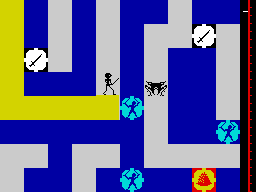
 99 -
Maziacs (DK 'Tronics) 99 -
Maziacs (DK 'Tronics)
The
advertisements for this claustrophobic maze game (actually an update
of Mazogs, probably the most popular ZX81 game ever) claimed that the
fight sequences were choreographed with the aid of a real live
stuntman, and for once you could almost believe it. It wasn't a game
for arachnophobes though, as seeing your brave little adventurer
clamped broken-backed between the jaws of an evil spider-like Maziac
was enough to put a shiver up the spine of all but the most stout of
heart. Maziacs was a game with more character than a thousand
Turricans, and more horror than all the Nightmare On
Elm Street movies
put together.
|
|
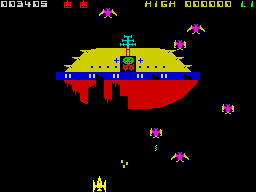
 98 -
Pheenix (Megadodo) 98 -
Pheenix (Megadodo)
There are people
who would have you believe that Pang, or Toki, or even Midnight
Resistance represents the pinnacle of the art of Speccy coin-op
conversion. Not so. The true zenith was reached as far back as 1983,
with this flawless - except for the spelling, anyway - copy of the
arcade game Phoenix (forerunner of this year's Megaphoenix from
Dinamic). It's still the zappiest Space Invaders-type shoot-'em-up
there is, and if you don't need higher education to play it, well, who
gives a monkey's?
|
|
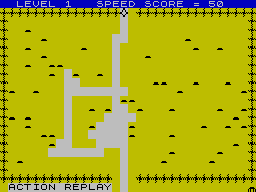
 97 - Mined
Out (Quicksilva) 97 - Mined
Out (Quicksilva)
There aren't many games in
this Top 100 written in BASIC. That won't surprise anyone. But what
might surprise you is the quality of this one. Mined Out set the player
down in an almost-blank screen full of invisible mines and challenged
you to reach the other side with the aid of a mine detector which told
you how many mines were beside you, but not where they were. The
resulting logic puzzle made for one of the greatest mind-teasers ever
devised, and when the later levels added a distinctly ponderous
chaser, the frantic self-inflicted pressure could make a bald man of
Jon Bon Jovi.
|
|
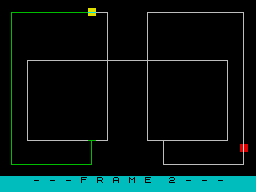  96 -
Cruising on Broadway (Sunshine) 96 -
Cruising on Broadway (Sunshine)
Take a look at
that screenshot. Does it look like the dullest thing you've ever seen
on a Spectrum screen? If it does, think again, because to a veteran
gamer it looks like a pic of one of the most addictive games ever to
grace a computer screen. Cruising was a painting game, where you
controlled a character square around a series of mazes made up of
single-pixel lines, pursued by another character square (or on later
levels, two other character squares). And that was all. The only way
to discover just how compulsive it was, though, is to play it.
Alternatively, you could always take my word for it. I wouldn't lie to
you.
|
|
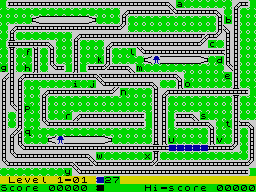
 95 - The
Train Game (Microsphere) 95 - The
Train Game (Microsphere)
...or How I Learned
To Stop Worrying And Love British Rail. Once you've played The Train
Game, you'll forgive BR for every delay they've ever had. Y'see, the
terrifying pressure brought on by trying to direct half-a-dozen trains
simultaneously around a track with 26 sets of points, stopping them
from crashing into each other or derailling. Diverting runaway locos
away from potential disaster and keeping five or six platforms full of
impatient commuters happy all at the same time is almost too much to
bear in a Speccy game, never mind doing it for real. A perfect
difficulty curve leads you up the garden path, then The Train Game ties
you to the tracks and runs over your head.
|
|
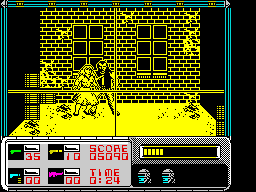
 94 - Robocop
(Ocean) 94 - Robocop
(Ocean)
I shouldn't have to blow a trumpet for
this game, and I don't need a drum either to beat up support for
possibly the longest running title on any computer games chart since
the dawn of time. Robocop's mix of perfectly-executed sub-games kept
it at No. 1 for almost a whole year after its release, and it's easy
to see why. (And indeed hear why - it's got some of the loveliest music
in Speccy history.) Almost certainly the best movie conversion job the Speccy's seen, and probably the best one it's ever likely to.
|
|
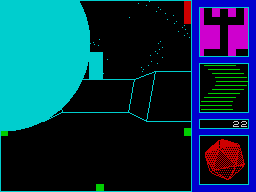
 93 - Gyron
(Firebird) 93 - Gyron
(Firebird)
It's almost inconceivable these days,
but the reward for completing this game wasn't a naff little well-done
message, or a pretty picture inviting you to buy the 'coming soon'
sequel. Nope, for finishing Gyron, you got a Porsche. A real one. Of
course, it wasn't easy - the team of mathematicians who programmed the
maze and the movements of its guardians to repeat only once every
10,000 years saw to that, but it was such an absorbing game that, for
many players, 10,000 years didn't seem too long to wait.
|
|
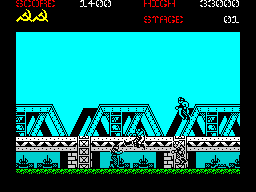
 92 - Green Beret
(Imagine) 92 - Green Beret
(Imagine)
A pretty low-key release on the
resurrected Imagine label, Green Beret nevertheless quickly became one
of the Speccy's most-played games. It's hard to put your finger on
quite why it works so well. You could certainly never accuse it of
being too involved, but the utter simplicity defies you to accept that
you've been killed yet again, and makes you start another game before
you've realised the last one was finished. I still play this game, and
I've never been to Level Four. 'Nuff said.
|
|
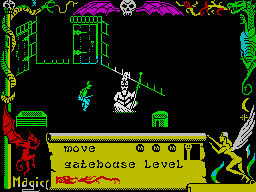
 91 - Avalon
(Hewson) 91 - Avalon
(Hewson)
In its time, Avalon was called 'the first
adventure movie'. If that's true, it would have to be a David Lynch
movie, because I haven't got a clue what's going on in it half the
time. Still, you could well argue that this game was a direct ancestor
of Fantasy World Dizzy and the like, with its mix of adventure,
puzzle, and arcade skills calling for a real all-round effort to make
any progress. This wasn't a game to pick up for a few minutes - Avalon
drew you in and demanded all of your attention, and it usually got it.
|
|
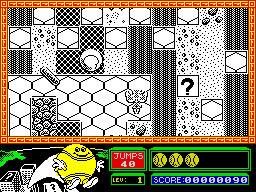
 90 - Bounder
(Gremlin) 90 - Bounder
(Gremlin)
A strange fish, this. You played a
tennis ball with a mission to bounce across a city full of skyscrapers,
placed just closely enough together for you to be able to stretch from
one to the next. At least it looked that way. But the frequency with
which you found yourself plummeting to the ground, or impaled on some
obstacle, or burst by one of the horrible aliens (who always popped up
where you wanted to go) suggested there was trickery afoot. Of course,
the next time, the next time, you'd be ready for it...
|
|
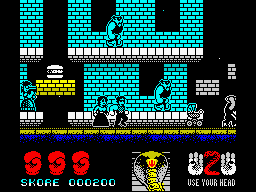
 89 - Cobra
(Ocean) 89 - Cobra
(Ocean)
Humour and Sylvester Stallone aren't
normally two things you associate with each other. Unless, that is,
you've played this brilliant platform game where laser-sighted machine
guns are hidden in hamburgers and babies in prams paralyse our hero
with fear, enabling the bad guys to kidnap his sweetheart and then
shoot him into lasagne. The connection with the dire movie was
extremely tenuous, but the game was such fun that nobody cared.
Besides any game which asks you to define a 'murder' key is okay by
me.
|
|
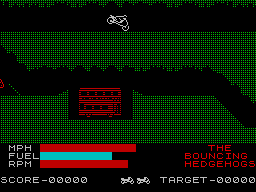
 88 -
Wheelie (Microsphere) 88 -
Wheelie (Microsphere)
Another game
where playing to lose was more fun than trying to win. Your motorbike-riding hero took such spectacular dives when you crashed him into a
double-decker bus that it was well worth losing a life or five to see
it. All the same, even when you got bored of that, Wheelie was a great
game in its own right, with a gloomy, sinister atmosphere and it was
challenging enough to keep you at it for quite a while. Without a
shadow of a doubt
the greatest underground motorcycling game ever made.
|
|
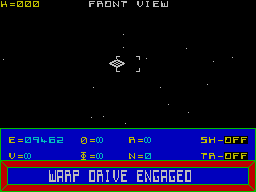
 87 -
Codename MAT (Micromega) 87 -
Codename MAT (Micromega)
Or Mission: Alien
Termination, which doesn't convey the amount of brainpower called for
in this second-generation Star Trek game which was probably the first
to put you in control of more than one ship or character at one time.
In many ways it was more complex than, say, Elite, it could still be
played more or less as a straight 3D space shoot-'em-up, and it was
this instant playability that made it such an enormous hit in its day.
Yes, you too could blow up the entire solar system with Codename MAT.
|
|
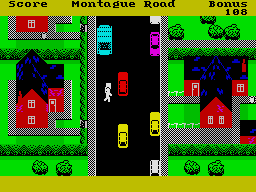
 86 -
Trashman (New Generation) 86 -
Trashman (New Generation)
If I was to
tell you that this game captured perfectly the feeling of being a
dustbin man in a leafy suburb on a sleepy Sunday morning, would that
make you want to play it? If not, you don't know what you're missing,
because Trashman is just about the loveliest and most relaxing game
you could ever hope for. Combining Frogger with Terry And June-style
humour might not seem like the ideal recipe for a classic (and, under
any other circumstances, it most certainly isn't), but in this case it
works perfectly. Play it and love it.
|
|
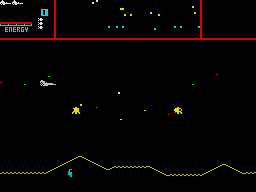
 85 -
Guardian 2 (Hi-Tec) 85 -
Guardian 2 (Hi-Tec)
Or Stargate by any other
name. Williams' monster classic arcade games have been oft imitated on
the Speccy (most notably by Interstella's Defenda and Softek's
Starblitz), but this angry monster of a game is the first one to truly
capture that 'locked in a cupboard with a swarm of psychotic hornets'
feel of the original. Tough enough for all but the most dedicated zapper, this game
will have you punching the keys off your Spectrum in frustrated rage.
And then having another game. Unputdownable.
|
|
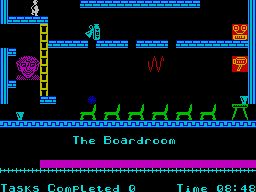
 84 -
Technician Ted (Hewson) 84 -
Technician Ted (Hewson)
This game set a whole
series of standards in Speccy gaming. It was the first (and, indeed,
practically the only one to this day) to have an animated loading
screen, the first to have pixel-perfect collision detection, and the
first Manic Miner-type platform game to call more on brainpower than
ladder-leaping precision. Not to say that there wasn't plenty of that
needed too though. Massively difficult but equally compulsive,
Technician Ted was the peak of a genre, and the end of an era.
|
|
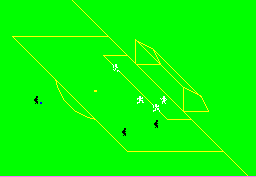
 83 -
Football Manager (Alternative) 83 -
Football Manager (Alternative)
Or the game
that etched the face of a fat, bearded old man called Kevin on to the
minds of 100,000 Spectrum owners forever. Written in BASIC, and with a
lack of depth bordering on the insulting, Football Manager still
somehow contrived to be one of the most gripping games in the
Spectrum's history. There isn't an FM player alive who hasn't found
himself shouting at the players during the animated (ha!) highlights sequences, and
the 101 tedious number-crunching copies that have followed it all
somehow failed to grasp that this was just what made Football Manager
so wonderful.
|
|
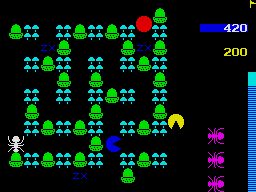
 82 -
Hyperaction (Silversoft) 82 -
Hyperaction (Silversoft)
One of the
best games never to sell a dozen copies, Hyperaction was a Pengo-like
puzzle game with hidden qualities that belied the simplicity of the
two-rule gameplay (trap the monsters with the moveable blocks; don't
squash them). Years ahead of its time, this is the kind of thing
that screams for a second chance and it's a tragedy that so few people
have ever had the chance to curse and swear at it. Write a letter to
your favourite software house now, demanding that they buy it up and
re-release it. Or would you rather play Sooty and Sweep for the rest
of your life?
|
|
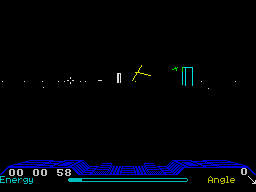
 81 - Dark
Star (Design Design) 81 - Dark
Star (Design Design)
Every picture I paint
with a screenshot completely fails to capture the nature of Dark Star. Arguably
the biggest cult game ever, the staggering speed of the game was what
lifted it out of the mire and into the stratosphere (where only the
best games can breathe the air). Like the arcade's Star Wars in many
ways, Dark Star also boasted the best named starship of all time (the
Liar), the most redefinable keyboard of all time, the best high-score
tables of all time, and the best giveaway Teletext spoof of all time.
Er, okay then, the only giveaway Teletext spoof of all time. (Nearly.) Trop
belle pour toi.
|
|
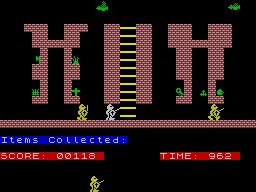
 80 - Sir
Lancelot 80 - Sir
Lancelot
(Melbourne House)
If you've got any friends with
16-bit machines complaining that their best games don't fit into 512K
of memory, why not show them this? A classic platforms-and-ladders
game with sharp graphics, loads of speed, and more addictiveness than
a big bag full of really addictive things, Sir Lancelot was programmed in
just over 9K. Yes, nine. Not only a great game but an amazing feat to
boot, it makes you wonder what they're feeding programmers these days.
|
|
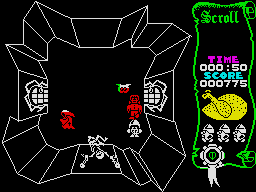
 79 -
Atic Atac (Ultimate) 79 -
Atic Atac (Ultimate)
In the early years
buying Speccy games was a fraught business. Software houses sprang up
and folded daily and gamesplayers had to
suffer any number of pig-in-a-poke purchases. But there was an eternal
light in the gloom - Ultimate Play The Game. They took the Speccy closer to its
limits with every release and Atic Atac was only the first in a long
line of true classics. The design is nothing out of the ordinary, but
the care and attention lavished on every detail of this arcade
adventure makes it a joy that anyone who calls themselves a games
lover should own.
|
|
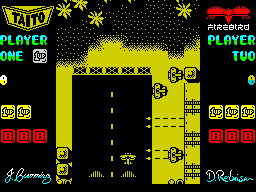
 78 - Flying Shark
(Firebird) 78 - Flying Shark
(Firebird)
This came out just around the time when
software houses started releasing games on the 16-bit machines only,
and it proved (if proof was needed) that the 8-bits were more than up
to anything their big brothers could manage. In terms of gameplay this
is a near perfect copy of the coin-op original, and the graphics are
as good as any you could ask for. Not many players ever finished it,
but if you fancy trying to join the elite you couldn't ask for a
better vertically-scrolling shoot-'em-up to test your skills against.
|
|
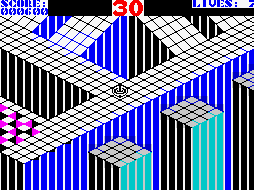
 77 - Gyroscope 77 - Gyroscope
(Melbourne House)
Marble Madness was something of
a Holy Grail for Spectrum software developers in the 80s, but the only
game which came close to the arcade's abstract beauty was this
shameless clone. Slick and pretty, it was also fiendishly tough, and
it kept many a talented gamer glued to the screen in the early hours
of many a morning. The scrolling judders horribly, but in the game
everything flows so well that you just don't notice. Well, you might
notice, but you just don't care.
|
|
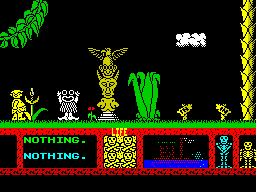
 76 - Three Weeks In
Paradise (Mikrogen) 76 - Three Weeks In
Paradise (Mikrogen)
Everybody's fool,
Wally Week, was one of the most unlikely computer gaming heroes ever.
Pot-bellied and flat-capped, Wally and his sad family starred in a
series of classic arcade adventures that probably more than anything
led to hugely popular Dizzy series and imitators which seem to make up
half of today's Speccy releases. Three Weeks In Paradise was
the most accomplished of the lot and, if you want a perspective,
imagine Treasure Island Dizzy's sexy older brother and you'll be
halfway there.
|
|
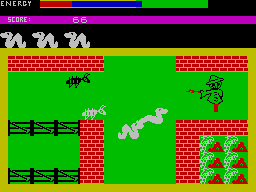
 75
- Wriggler 75
- Wriggler
(Romantic Robot)
There are of course, hundreds of games which ask you to swallow
your biological pride and play a worm, but Wriggler is undoubtedly
the No 1. Beautifully animated graphics, bright, lush colours, big
scary beasties for enemies and classic arcade adventure gameplay
made for a game which could have changed the public perception of
hermaphrodite non-vertebrates forever, if only anyone had ever
bought it. Wriggler had all this and heavy metal too. Why don't
you ever get free soundtrack tapes with games any more?
|
|
|
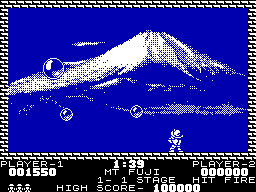
 74
- Pang
(Ocean) 74
- Pang
(Ocean)
While this curious Galaxians-meets-The Prisoner slice of harpoons 'n'
balloons tomfoolery isn't actually as original as everybody thinks it
is, what's undeniable is that it's one of the best straightforward
old-fashioned arcade games the Speccy's seen in a long time. A superb
conversion of the coin-op, Pang is a game that will have you blowing
(up) bubbles forever, not to mention punching out your friends if you
play the infuriatingly novel two-player option.
|
|
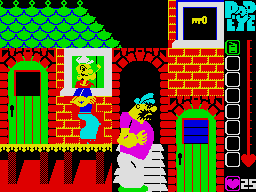
 73
-
Popeye (DK 'Tronics) 73
-
Popeye (DK 'Tronics)
The Spectrum's straining technology was stretched to critical mass by
this incredible game. The truly gorgeous graphics, where characters
stretched half the height of the screen and were packed with non-clashing colour, stunned
everyone who saw them. But they were only part of the appeal of a
tricky arcade adventure with more imagination than most of its
contemporaries put together. Don Priestly, the programmer, took this
style further with his subsequent (and brilliant) Trap Door games, but
Popeye was still the original and the best.
|
|
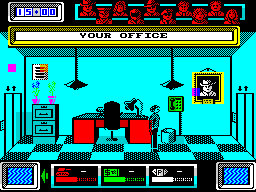
 72
- Hijack (Electric Dreams) 72
- Hijack (Electric Dreams)
Most of you should already know how good this strategy epic is, 'cos
we gave it to you free on the covertape a couple of months back. Still,
it doesn't hurt to mention it for the benefit of any latecomers - this
is a game which proves the Spectrum is more than capable of holding
its own when it comes to games of depth and intelligence. Surprisingly
atmospheric, Hijack was also one of the most original ideas in years.
The fact that it didn't sell more is more an indictment of game buyers
than of the actual game. Take the padlock off your brain and give this
a go. You'll be pleasantly shocked.
|
|
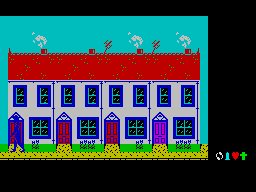
 71
- Frankie Goes To Hollywood (Ocean) 71
- Frankie Goes To Hollywood (Ocean)
Remember Frankie - the most controversial band of the 80s? Parents
said they were the classic example of a Catholic education gone wrong,
but didn't the kids just love 'em? Ocean stunned everyone, first by
buying the license and then by resisting the temptation to cobble
together a quick rip-off platform game. Instead they presented us with
one of the most insidiously charming and bizarre games they'd ever
released. Only a bug which prevents it from being completed properly
kept this one from the Top 20, but it's still a bona fide classic.
|
|
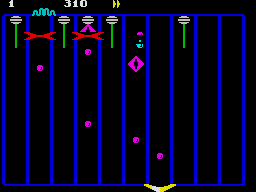
 70
- G-Force (Euro-Byte) 70
- G-Force (Euro-Byte)
Of all the Tempest games available for the Speccy, official or clone, G-Force is almost certainly the most obscure. This is a bit of a shame 'cos it's easily the best. Forsaking the tricky geometric-shaped webs of the original for straight rectangular screens, Euro-Byte used the extra freedom this gave them to produce a game that looked like no other on the Speccy - big chunky graphics zipping around the screen in huge numbers and speed that refused to let up no matter how much was happening on screen. G-Force recreates the
spirit of the original coin-op better than anything I've seen.
|
|
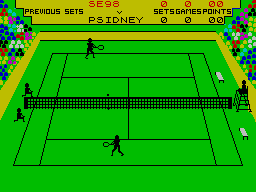
 69
- Match Point (Psion) 69
- Match Point (Psion)
For some bizarre and unexplained reason, tennis has always been one of
the most popular subjects for computer game writers (indeed, Pong, the
first ever video game, was a tennis sim of sorts). Match Point is one
the earliest attempts on the Speccy and it can still show all the
subsequent efforts a thing or seven about natural,
uncomplicated-but-flexible controls. Understated but beautifully
animated graphics, a wide range of skill levels and other options
ensure that players of all ages, talents and attention spans get
never-ending enjoyment out of it. Unsurpassed in its field. (Court.
- Ed)
|
|
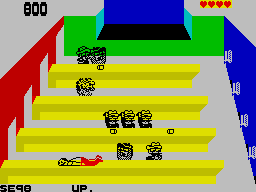
 68
- Tapper (US Gold) 68
- Tapper (US Gold)
Or as it would have been if Codemasters had released it - Advanced
Barman Simulator. Yep, the sole purpose in life for your character in
Tapper was to serve drinks to a never-ending flow of thirsty punters
who were apt to sling him the length of the bar if their (ahem) 'soda'
wasn't delivered promptly. Cleaned up from the arcade original (where
the glasses were filled with beer), this conversion nonetheless
retained all the frantic fun of the coin-op, with a fair touch of
humour to boot. Oh, and the dancing alien girls were worth seeing too.
|
|
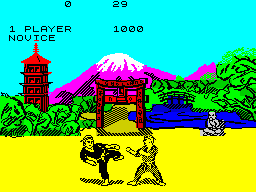
 67
- Way
Of The Exploding Fist (Melbourne House) 67
- Way
Of The Exploding Fist (Melbourne House)
The first real Spectrum beat-'em-up and still the best. Fist's crisp,
elegant graphics, instinctive control system, wide range of moves,
precise collision detection and crunching sound effects make it more
than a match for anything which has been released since. You really do
wince when your fighter takes a punch in a sensitive area and crumples
to the ground. It's this character that makes Fist stand head and
roundhouse above all the competition. Inscrutably beautiful.
|
|
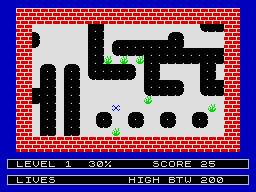
 66
- Splat! (Incentive) 66
- Splat! (Incentive)
Speech on the Spec, eh? Mostly it went 'mxchxtrrrbkstxtprrkkk',
but in Splat! the joyous 'Yippee!' your character Ziggy (an 'X'
with legs) let out after completing a level was crisp and coherent.
Amazingly though, it was just about the least impressive aspect of
this enormously original and monstrously addictive scrolling maze
game, where your character stayed in one place, the maze moved around,
and the edges of the screen were the game's main danger. Deceptively
fast-paced and always exciting, this is the kind of game that you just
never see any more. What's happened to all the new ideas?
|
|
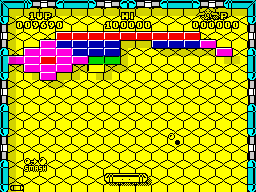
 65
- Batty
(Encore/YS) 65
- Batty
(Encore/YS)
This is still the best Arkanoid-style game available for the Spec,
better in my opinion than even the hugely popular Arkanoid 2. With
fast smooth, clear graphics and a serious level of challenge you'd
think this would've been a huge chart success. But (but!) Batty was
never even released as a full-price game. It's criminal! First a covertape freebie with Britain's Brightest and Biggest Sinclair Magazine (you're reading it, dolt) and then a budget game, Batty
was the best game Elite never put their name to.
|
|
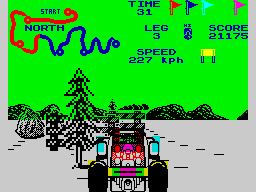
 64
- Buggy
Boy (Elite) 64
- Buggy
Boy (Elite)
Is this the biggest sprite ever seen on the Spec? Probably not (see
Popeye above), but Buggy
Boy had more to recommend it than a huge and colourful dune-hopper
anyway. A
racing game without breakneck racing-game pace, Buggy Boy compensated with beaut
graphics, lots of varied courses and imaginative and addictive
gameplay. Steering a buggy across a precarious and obstacle-littered
bridge on two wheels is a challenge for the most talented, but this
game's main attraction is pure and simple sweetness. If that seems a
bit of an intangible concept, play it. You'll see what I mean.
|
|
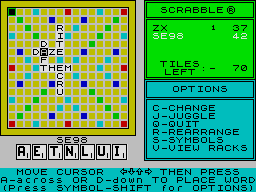
 63
- Scrabble (Psion) 63
- Scrabble (Psion)
This is really touching. Scrabble plays a great version of the classic
word game with an 11,000 word vocabulary in just 48K. It's most
endearing feature is that if you enter a word like 'QXWWVAR' on a
triple word score box, it'll ask you if you're sure its a legal word,
then if you reply 'yes', it actually believes you! What's more, it adds
the word to its vocabulary so, if you use it again, it won't even
question it! Now that's what computers were always supposed to be
about, none of this taking over the world nonsense. Play Scrabble and
feel superior.
|
|
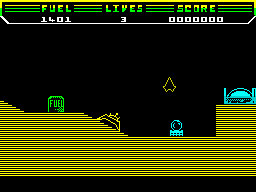
 62
- Thrust
(Firebird) 62
- Thrust
(Firebird)
Another budget-only classic, Thrust borrows heavily from classic
arcade games like Asteroids and Gravitar and then adds some serious
physics to produce a tense and tricky game of precision manoeuvring
and panic-stricken blasting. If you've never had the opportunity to
battle against a Level 4 planet with reverse gravity and a heavy pod
swinging beneath your spaceship threatening to slam you against a
cavern wall in the blinking of an eye, then you just haven't lived,
buddy. Can you believe that this lovely was just £1.99? I can't, and I
bought it.
|
|
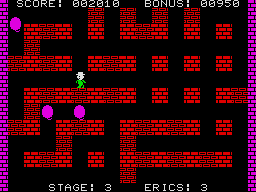
 61
- Eric And The Floaters (Sinclair) 61
- Eric And The Floaters (Sinclair)
Crude, jerky graphics, simplistic gameplay, awkward control keys and
dull, lifeless colour are just a few of the 'features' which
completely failed to wreck the appeal of this strange and brilliant
little arcade game from Japanese software house Hudson Soft. The only
thing it really had going for it was the incredible addiction brought
on by it's deceptively tricky nature and Tetris-style
'finish the screen or go for the big but risky bonus?' dilemmas, but
then, what else do you need? That it's still getting rave reviews (in
a slightly revised form) on the console machines is proof of just how
timeless it's appeal is.
|
|
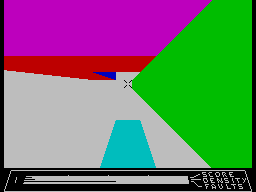
 60
- Knot In 3D
(New Generation) 60
- Knot In 3D
(New Generation)
New Generation were one of the first software houses to write for the
Sinclair machines. For me, this is the very pinnacle of their
achievements. A kind of Tron light cycles game,
but set in a 3D spherical cube (look, play the game, you'll
understand), Knot looked incredibly bizarre. To play it though, all
you needed was a keen sense of spatial relations and fast reactions,
and your reward was a gameplay experience which could be nothing short
of breathtaking. Completely unique and absolutely gorgeous.
|
|
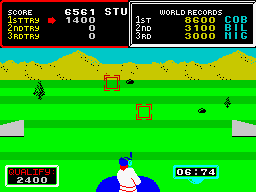
 59
- Hyper Sports (Imagine) 59
- Hyper Sports (Imagine)
Or The Game That Smashed A Thousand
Speccies. Joystick-waggling (or keyboard-pounding) multiple-sports
games were all the rage back in 1984, after the coin-op Track And
Field (later converted appallingly to the Spec on an Imagine
compilation) gave millions of arcade athletes blistered and bleeding
hands for weeks, attempting to recreate the Olympics with two fingers.
Hyper Sports was a touch more thoughtful than the rest, calling for
skill and timing as well as pure brute force, but that didn't mean
your machine wasn't going to take the most fearful hammering anyway as
you strained realistically to lift the 250kg bar in the weightlifting
section. Violent but beautiful. (Just like Wild At Heart)
|
|
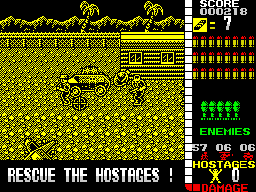
 58
-
Operation Wolf (Ocean) 58
-
Operation Wolf (Ocean)
More than anything else, Operation Wolf is a triumph of 8-bit
practicality over 16-bit aesthetics. On the big machines, this is a
great-looking copy of the arcade game made unplayable by disk
swapping. But the Speccy version packs in all the arcade thrills in a
fast-moving game of massive slaughter where the action never lets up.
A mindlessly violent game, Op Wolf spawned a hundred clones, but none
of them matched it for sheer brutality, speed and slickness. This is
such a good game that you won't even miss the plastic machine gun.
|
|
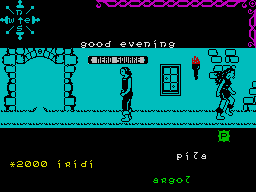
 57
- Dun Durach (Gargoyle) 57
- Dun Durach (Gargoyle)
It was hard to pick just one of Gargoyle's series of games (which also
include Tir Na Nog, Marsport and Heavy on the Magick). But the
overwhelming atmosphere of Dun Darach won out. A whole city was yours
to explore, complete with bars, gambling houses, and all manner of
shops where you could even get a job to make yourself a bit of cash.
Dun Darach was one of the most involving games ever written, and if
you haven't got one I strongly suggest you get one. Then cancel all
appointments for a week, and discover it yourself.
|
|
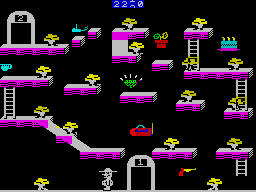
 56
- Bounty Bob Strikes Back (US Gold) 56
- Bounty Bob Strikes Back (US Gold)
The sequel to the first ever platform-and-ladders game, although that
game (Miner 2049er) didn't appear on the Spec. Bounty Bob Strikes
Back took a traditional approach to the timing-and-climbing style, but
the screens were so ingeniously designed and the whole thing was so
thoughtfully done that it transcended the formula to be one of the
most playable games ever in the genre. Un-Speccy-like graphics gave it
a unique look too, and there's no harm in that.
|
|
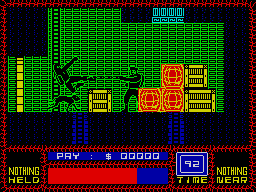
 55
-
Saboteur (Durell) 55
-
Saboteur (Durell)
Famous (well, it depends on how old you are) for being The Game That
Didn't Give You Any Points For Shooting The Dogs. ('So why bother?',
as the manual pointedly asked).
This was a masterful piece of psychology, as the dogs (guard dogs on
the installation you were trying to sabotage) snapped at your heels so
annoyingly that you really wanted to kill them, but couldn't because
your conscience wouldn't let you. This of course meant that you got
yourself killed with embarrassing regularity, but you just couldn't
bring yourself to do anything about it. Damn sneaky. (Oh, and it was a great game too.)
|
|
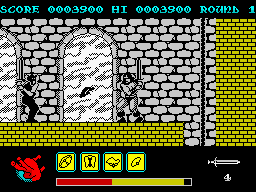
 54
- Rastan
(Imagine) 54
- Rastan
(Imagine)
One of the best-looking Speccy coin-op conversions ever, with big,
sharp graphics and atmospheric backdrops giving it a real feel of the
epic swords-and-sorcery arcade game from Taito. Rastan was the classiest of a whole load of generic
muscle-fantasy orc-slashers which were popular a couple of years back
and it retains all the elegance (and violence) of the original. It's
not the most innovative piece of design ever, but the best of any genre
is always worth having, and that's exactly what this is.
|
|
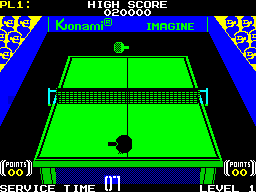
 53
- Ping
Pong (Imagine) 53
- Ping
Pong (Imagine)
Ping Pong? Great idea for a computer game, I must say! Actually, this
Konami coin-op conversion is one of the most playable sports sims
ever. Your bat follows the ball, leaving you only with the playing of
the actual shot to worry about. This frees you from all that tedious
trogging around and makes the game an exercise in tactics and
reactions. Slick presentation and brilliant music add to the
enjoyments of this simply beautiful piece of software. Ping Pong is an
object lesson to programmers everywhere in how to Do It Properly.
|
|
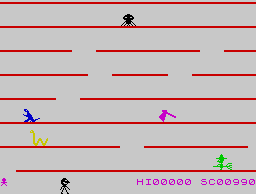
 52
- Jumping Jack (Imagine) 52
- Jumping Jack (Imagine)
Jumping Jack is every bit as simple as it looks, but the simple
graphics hides a game of almost frightening addictive qualities. All
you have to do is jump through moving holes to the top of the screen,
but miss one and Jack falls stunned to the ground. While he regains
composure, you can be sure that another hole will sneak up on him (or
one of the ever-more-numerous baddies),
until he ends up back at the bottom of the screen, leaving even the
most hardened gamer in tears of frustrated rage. This is a game that's
practically unputdownable.
|
|
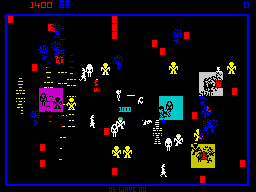
 51
- Robotron (Atarisoft) 51
- Robotron (Atarisoft)
You might have read that Williams' Smash TV prequel Robotron never
made it to the Spectrum, but that's only half true. It was never
released, but it was written and even reviewed but tragically and
inexplicably never saw a shop
shelf. A superb conversion of a coin-op many thought to be impossible
for the Speccy to handle, with huge numbers of enemies on screen at
a time completely failing to slow down the action. Nothing was missed
out except for the chance for zap fans to actually buy the thing, and
that's nothing short of criminal.
|
|
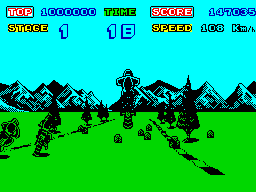
 50
-
Enduro Racer (Activision) 50
-
Enduro Racer (Activision)
I could do a Top 100 of motorbike racers alone. But in any genre there
are standouts and this is by far the best one involving having to jump
across rivers by wheelying into logs and riding around the backs of
palm trees on a beach (ahem). Enduro Racer is the slickest and
prettiest racer around, and it's the kind of game that still won't be
showing its age in 20 years time. If you ever wanted to cross Out Run
with Helter Skelter, this is the game for you.
|
|
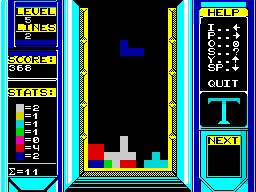
 49
- Tetris
(Mirrorsoft) 49
- Tetris
(Mirrorsoft)
Yes, it's the game that makes Amiga and ST owners look at your
Spectrum with real jealousy, 'cos the Speccy version of this classic
Russian reaction-tester out performs the 16-bit ports every time. In
avoiding the temptation to dress the game up unnecessarily with
complicated graphics and pointless shimmering backdrops, Mirrorsoft
made sure that Tetris on the Speccy captured all the pure compulsion
of the original without distractions. Even though it's been done a
dozen times on the big machines, the Speccy version is still the best
Tetris you can buy.
|
|
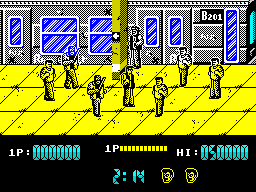
 48
-
Renegade (Imagine) 48
-
Renegade (Imagine)
Never mind your Final Fights, never mind your Way Of The Exploding
Fists, never mind your International Karates, this is comfortably (if
that's the right word) the most brutal beat-'em-up there's ever been.
Eye-watering knees-in-the-groin, sickeningly vicious headbutts,
enemies ganging up to hold a player's arms while someone else punches
the living daylights out of him, and the player retaliating with
flying kicks at speeding motorcycle riders. (Don't try this one at
home, kids.) And all without the slightest danger of ending up in
Casualty - what more could you ask?
|
|
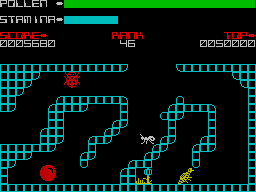
 47
- Antics (Bug-Byte) 47
- Antics (Bug-Byte)
There's no shortage of games which call on you to rescue someone or
other. Most of them simply ask you to battle through a hostile
scenario and reach your goal, at which point everything magically
becomes alright. However, in Antics when Barnabee (the bee) reaches
his kidnapped cousin Boris (the, er, bee), the story is only
half-complete. Barnabee has to guide the weakened and slow-moving
Boris all the way back to the start again and, if he goes too fast,
poor Boris gets all confused and lost. The frantic rush to go slowly
(if you see what I mean) against a tough time limit makes this just
about the most heart-wrenching
game in the whole world. Aw shucks.
|
|
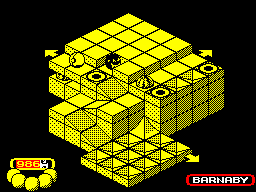
 46
-
Bobby Bearing
(The Edge) 46
-
Bobby Bearing
(The Edge)
Or Spindizzy with balls. This beautiful game never achieved
the success it deserved for reasons which escape
me. It's another Marble Madness-alike, but whereas Spindizzy was
all sharp angles and sudden edges, Bobby featured properly rolling
balls, round tunnels and curved surfaces.
It also called on you to act the good shepherd and herd other
characters around. If pushing a marble across a curved slope with
another marble (while contending with moving blocks, nasty enemies and
sudden gusts of wind) sounds a tricky proposition to you, then you're
halfway to understanding what made this game so incredibly addictive.
|
|
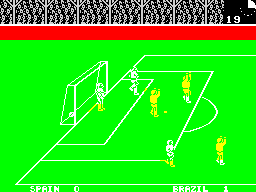
 45
- International Match Day (Imagine) 45
- International Match Day (Imagine)
'There's only one International Match Day, one International Maaatch
Day, there's only one...' It doesn't really work does it? All the same, there IS only one International Match Day,
and it's the best (but least well-known) of this incredibly popular
series of Spectrum footy games. IMD was
slicker than Match Day and more playable than Match Day 2 but
unfortunately, it was only available for the 128K machine. It's still
worth searching out if you're an enhanced Spec-chum in search of the
ultimate soccer experience. Kick Off? Gazza 2? Don't make me laugh.
|
|
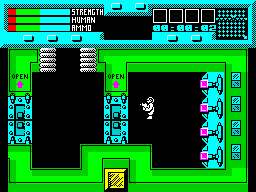
 44
- Rescue (Mastertronic) 44
- Rescue (Mastertronic)
A classic budget game, there isn't really anything outstanding about
Rescue at all. The graphics are great but not outstanding, the sound
is zappy but nothing remarkable, the number of rooms and so on isn't
anything out of the ordinary, and the runaround-arcade-adventure-zapping-collecting-and-rescuing
(obviously) game design has been seen a thousand times before. So why
do I love it so much? To tell you the truth I'm not entirely sure.
Until I can put it into words, just trust me. I know I'm right.
|
|
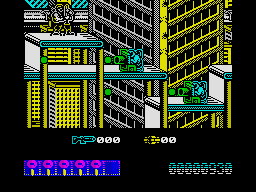
 43
-
Midnight Resistance (Ocean) 43
-
Midnight Resistance (Ocean)
These days coin-op conversions on the Spectrum tend to be
production-line churn-'em-outs that are nothing but pale-faced
mumbling shadows of their ST and Amiga counterparts. What a rare
pleasure then, to see one turn out as good as this. Programmers
Special FX refused to take the easy way out and do yet another
monochrome yawnerama. Instead, they gave us an action-packed blaster
which positively glowed with 8-bit pride, not to mention lovely
colourful graphics stuffed with life and character. This is the game
that proves the Speccy can still compete with anything.
|
|
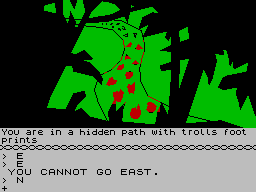
 42
- The Hobbit 42
- The Hobbit
(Melbourne House)
Oh goodness, it's an adventure! Well, it had to be done. The Speccy's
first successful adventure is also, to this day, one of the best.
Converted faithfully from the book with all the characters present and
correct. The Hobbit perplexed gamers for months on end. Luckily, it
was so rewarding that players stuck at it 'til the end. It's also the
game that introduced the phrase 'Thorin sits down and sings about
gold' into the national consciousness. No, I don't quite understand it
either, but that's adventure fans for you.
|
|
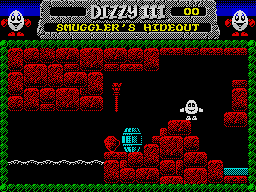
 41
- Fantasy World Dizzy (Codemasters) 41
- Fantasy World Dizzy (Codemasters)
Of all the Dizzy games, I decided to put this one in the chart because
of the character interaction, the well-balanced puzzles, the charming
atmosphere, but mostly because of the broad Glaswegian accent on the
speech sample at the beginning. (Are you trying to tell me you're
Scottish, Stuart? Ed). All the adventures of the world's cutest egg are
great games, but this one mixes together the best attributes of each
one to the best effect. It's also the game which finally made budget
software (not to mention Codemasters themselves) respectable.
|
|
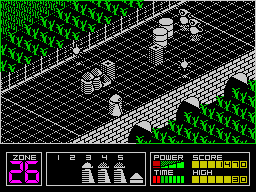
 40
- Highway Encounter (Vortex) 40
- Highway Encounter (Vortex)
Costa Panayi was quite possibly the Speccy's biggest ever cult
programmer. From humble beginnings with Android 1, he built up a
catalogue of incredible games that took the Spectrum closer to its
limits with each succeeding release. The stunning, colour-filled 3D
graphics and game plot (in its basic concept) predated the 16-bit
smash Lemmings by five years. So tricky that only the most dedicated
of gamers ever saw the last of the 30 screens of zapping-and-puzzling
action, but every second of it was a joy.
|
|
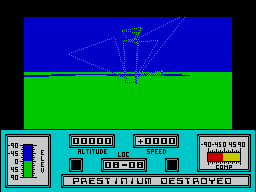
 39
-
Mercenary (Novagen) 39
-
Mercenary (Novagen)
Jon Pillar recently reviewed this as a budget re-release and gave it
99%. I'm not arguing. A bit like Elite played underground, Paul Woakes' epic of espionage, sabotage,
trading and blasting has an atmosphere of electric tension and
suspense which belies the simplistic look of the vector graphics.
Mercenary is clean, sharp, fast and deep enough to keep you playing
for weeks. What's more, it was visually indistinguishable from the
16-bit versions but with the kind of playability that you only ever
seem to get on the older machines. Now, more than ever, don't miss it.
|
|
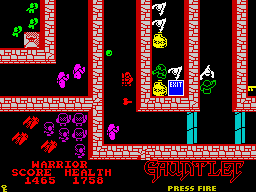
 38
-
Gauntlet (US Gold) 38
-
Gauntlet (US Gold)
Do I really need to tell anyone about Gauntlet? The arcade's
four-player epic of dungeons-and-dragon slaughter-filled mayhem
transferred to the Speccy better than anyone had dared to expect - US
Gold managed to cram every last level of the original game in, with the
aid of the least intrusive multiload in history. As a recreation of a
coin-op's feel it hasn't been bettered to this day, and as a game in
its own right it's as great as it ever was. One of the true milestones
of Spectrum gaming.
|
|
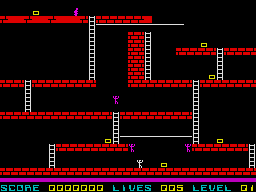
 37
- Loderunner
(Software Projects) 37
- Loderunner
(Software Projects)
It doesn't really look like one of the greatest Speccy games ever,
does it? What with those character-square red-and-black bricks with
tiny little white stick figures running around it. What you probably
don't know is that Lode Runner is just about the longest-running
computer platform game in the world, with roots going right back to
the Apple (ask your grandad), and all the way up to the GameBoy. A
game doesn't last that long without being something special and Lode
Runner's just that. Actually more puzzle game than platformer, it's
just one of the most addictive things ever. That's all.
|
|
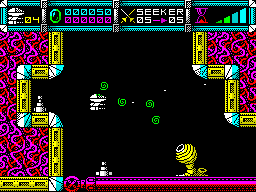
 36
-
Cybernoid (Hewson) 36
-
Cybernoid (Hewson)
Remember what I said about Costa Panayi? Well, forget it, because
Rafaele Cecco was an even bigger cult. The difference is that poor Raf only ever
wrote one really good game, and this is it. It has to be said that
flip-screen shoot-'em-ups with add-on weaponry aren't the stuff which
legends are usually made of. But the imagination, playability and
attention to detail of this one lifted it way above its origins and
into the realms of the unforgettable. It's worth getting just for the huge
maces which swing around your ship and pulverise everything, but it's
a fab game too.
|
|
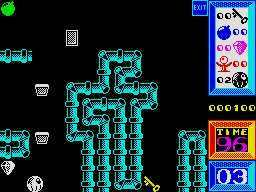
 35
- I, Ball 2 (Firebird) 35
- I, Ball 2 (Firebird)
Originality is something you don't see much of in the budget world.
Great though they can be, budgies tend to be simple rehashes of
previous successes. This game however, broke the mould and later
inspired programmer Tim Closs to write one of the best 16-bit games
ever, Kid Gloves. Basically a puzzle game, I, Ball 2 gleamed with
slick presentation and imaginative design, and all for £1.99. Don't
blow 12 quid on this month's latest crappy unoriginal licenced
rubbish, scour the bargain bins and find yourself a copy of this
instead. I promise that you won't be disappointed.
|
|
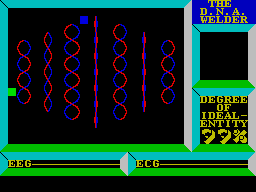
 34
- Deus Ex Machina (Automata) 34
- Deus Ex Machina (Automata)
This is probably the most ambitious entertainment software project
ever attempted on any home computer. Two loads full of stunning
graphics and a synchronised audio soundtrack including proper
real-life stars like Frankie Howerd and Jon Pertwee, coupled to a
madly over-the-top story of totalitarianism and genetic engineering,
made Deus Ex Machina an experience the like of which had never been
seen before or since. Genuinely affecting and disturbing at times,
this is software as art.
|
|
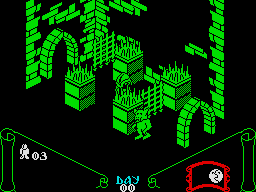
 33
-
Knight Lore (Ultimate) 33
-
Knight Lore (Ultimate)
We're really getting into 'legend' territory now. Knight Lore
was the game which pioneered the 3D isometric graphic style, later to be imitated into
oblivion by a hundred lesser designers. It took Spectrum graphics into
a whole new world, and up to a level which simply hadn't been believed
possible, even by the machine's creators themselves. The game was
(conveniently) brilliant too, and the traditional Ultimate Play The
Game polish gave
the whole thing a shine which was almost blinding. Revolutionary.
|
|
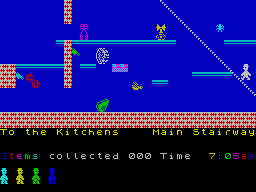
 32
- Jet Set Willy
(Software Projects) 32
- Jet Set Willy
(Software Projects)
This was probably the Speccy's most eagerly-awaited title ever.
Impatient gamers besieged shops for months until it finally appeared,
and no-one was disappointed. It's a superficially simple platform
epic (set in Willy's surrealist mansion) with some of the most
tortuous timing traps in the history of computer gaming and a genuine
'being there' feel which has rarely been topped. It looks a bit slow
today, but the superlative gameplay will soon make you forget about
that.
|
|
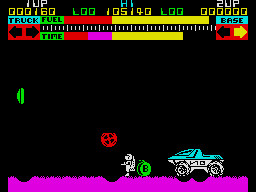
 31
-
Lunar Jetman (Ultimate) 31
-
Lunar Jetman (Ultimate)
"We triumph without glory when we conquer without danger", said the
French dramatist Pierre Corneille in 1636 and you know, I like to
think that when he said it he was thinking about Lunar Jetman. Ultimate's incredibly tough moon-based alien-stomper
was their first attempt at a game using the Speccy's expanded 48K
(wow!) memory, and what a stonker it was too. Hugely clever and funny,
it was also the game which you simply had to be able to play if you
wanted to have any peer status at all in 1985. Funny how things turn
out, isn't it?
|
|
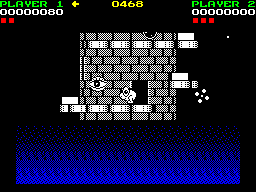
 30
- Nebulus
(Hewson) 30
- Nebulus
(Hewson)
Here's another game which (with versions newly out for the NES and
Game Boy) looks like transcending machine boundaries for years to
come. John Phillips' beautiful tower-ascending game featured amazing
rotational scrolling, but the truly staggering thing was that it was
overshadowed by the overwhelming addictiveness of the absurdly
addictive gameplay. Climb up, fall down, climb back up again and that
was about it. It just goes to prove (if there's still anyone out there
who doesn't believe it) that the simplest ideas are always the best.
|
|

 29
- Think (Ariolasoft) 29
- Think (Ariolasoft)
"We all are born mad. Some remain so. Especially if they've been
playing Think! for any significant period of time". So said top
twentieth century playwright Samuel Beckett (sort of). And he was
right too, because this 'board-game-you-couldn't-play-on-a-board' is
one of the most brain-torturing ever devised by mere mortal. The whole
balance of the game can alter with a single move, and if you can beat
the computer you've done something you can be proud of. (Woo! Party
time! - Ed) Take on a friend though, and you've got something that
can change the look of your face. If you're going to play this with a
chum, take your boxing gloves.
|
|
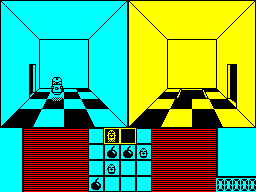
 28
-
Deactivators (Reaktor) 28
-
Deactivators (Reaktor)
Most puzzle games rely on their simplicity to be instantly graspable,
but Deactivators glories in complexity. Computer games have taken some
strange approaches to bomb disposal, but having robots roving around
in strange gravitational fields throwing the things through windows to
each other has to be the most ridiculous yet. It was all so tensely
gripping that players were completely hypnotised. If you're after some
seriously weirdo cyberpunk thrills, give Deactivators a try.
|
|
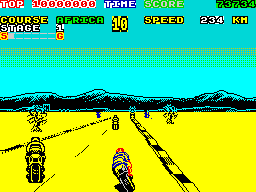
 27
-
Super Hang On 27
-
Super Hang On
(Electric Dreams)
Do you feel a need? A need for speed? Well, sod off. We don't need any
of that Tom Cruise nonsense round here, we're all too busy having fun
playing this immensely wonderful motorbike racing game to be bothered
with any dim-witted macho posturing. Super Hang-On is even more
thrilling than going for a ride with Andy O, and that's really saying
something. Fast slick and stomach-churning, this is the real thing
brought to life on a Spectrum with a vengeance, and with some pretty
spiffy graphics to boot. If you were born to be wild, grow up with
this.
|
|
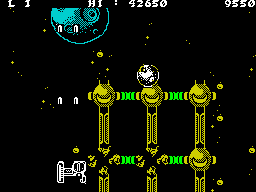
 26
-
Lightforce (FTL) 26
-
Lightforce (FTL)
Lightforce boasts the best use of colour in a Spectrum game there's
ever likely to be. FTL managed to pack this brilliant
vertically-scrolling shoot-'em-up with more colour than is actually
physically possible on the machine, and made it one of the very few
Speccy games ever to truly have the feel of an arcade game.
Lightforce plays as good as it looks. Lots of games can claim such an
accolade, but this is one of the few where it's actually a compliment.
|
|
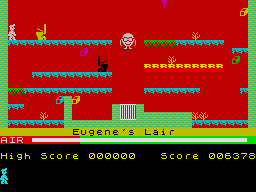
 25
- Manic Miner (Bug-Byte) 25
- Manic Miner (Bug-Byte)
It grieves me that some of you haven't heard of this. The first
real Speccy platform game, Manic Miner's character, sense of
humour, brilliant design and mammoth addictiveness (in fact, it's
even more addictive than a mammoth) made it one of the first true
computer gaming legends. It's still a great game, almost nine
years later, and I doubt if we'll be able to say the same of any
of today's games in the year 2000. Come to that, in the year 2000
I'll probably still be playing Manic Miner.
|
|
|
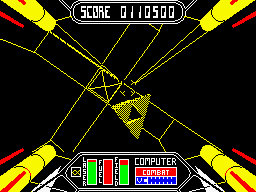
 24
-
Starstrike II (Realtime) 24
-
Starstrike II (Realtime)
Realtime made a name for themselves in the Speccy world with
Starstrike, their excellent clone of the arcade game Star Wars. This
sequel was so good that it improved on even the coin-op. Honest. The
fast moving solid 3D graphics are, with the possible exception of the
Freescape games, still the most impressive the machine's ever boasted,
and the game itself took Star Wars a step further and added a
non-intrusive strategy element to the space blasting. Stunningly
impressive, stunningly atmospheric, just stunning, really.
|
|
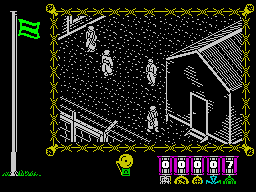
 23
- The
Great Escape (Ocean) 23
- The
Great Escape (Ocean)
And while we're on the subject of atmosphere, we'd better say a word
or two about The Great Escape. Much-feted programming team Denton
Designs had their finest moment with this mostly black and white
Colditz-style arcade adventure. It captured the POW camp feel
perfectly with the aid of an innovative design. The automatic ability
to wander around the camp simply obeying the rules and touching the
controls only when you wanted to do something naughty was a stroke of
genius. Even your score was calculated in medals! If your dad thinks
computer games are a waste of time, show him this.
|
|
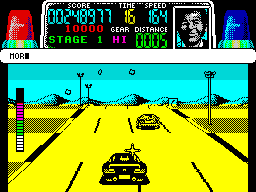
 22
- Chase
HQ (Ocean) 22
- Chase
HQ (Ocean)
After you've shown your Amiga and ST-owning chums Tetris, why not
really sicken them with this superlative driving game?
They'll be instantly converted to the Speccy gospel. Amazingly fast
and incredibly well programmed, Chase HQ turned a mediocre arcade game
into a Speccy classic. Even the title sequence was bursting with
character, and indicative of the kind of loving care that so few
people bother to put into Spectrum games any more. The added plot
gives Chase HQ an element of compulsion which lifts it into the realms
of the special. A treat.
|
|
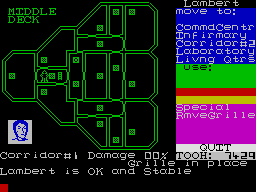
 21
- Alien (Argus) 21
- Alien (Argus)
Your Speccy might have done a lot of things in its time, but has it
ever scared you? (Explosions don't count.) If not, you've obviously
never played Alien. On the Spec, Alien was a tension-filled strategy
game where you controlled the entire crew of the Nostromo in an
attempt to blow the evil beastie up and escape to safety. Just like in
the film, the alien was wont to appear without warning from air vents
and munch a member of your team in seconds. The game was so taut that
when you did stumble across the old ET herself, even the neighbours
three doors down could hear
you scream.
|
|
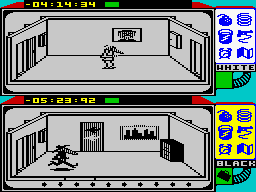
 20
-
Spy vs Spy (Beyond) 20
-
Spy vs Spy (Beyond)
This game must have ruined more friendships than any other. Spy
Vs. Spy is a supremely entertaining game. But try two-player mode and
you'd better be ready to experience ecstatic triumph and crushing
despair in a minute. The traps which the witless spies blunder into
are alternately hilarious or teeth-grindingly infuriating, depending
which side you're on. The split-screen display meant you had no excuse
for not spotting what your opponent was up to - all you could do was
get back up and perpetrate some of the same slapstick violence in
return. If both of you somehow forgot what the actual point of the
game was in all the excitement, well so what?
|
|
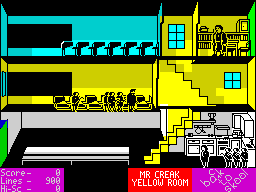
 19
-
Back To Skool (Microsphere) 19
-
Back To Skool (Microsphere)
Or the game that brought teenage romance back to the Spectrum. In the
sequel to the brilliant Skool Daze, Microsphere added a school full of
girls to the original formula of sneaky backhanded japery and unusual
escapades with amphibians. This was obviously a good thing. They ended
up with a game which provided many a Spectrum owner with some of the
happiest days of their lives. The wonderful atmosphere of Skool Daze
was just part of a recipe which also included incredibly devious
puzzles, a whole cast of genuine characters and superb graphics. Add a
combination of platform dexterity with beat-'em-up violence and
strategic planning for a game with a feel of completeness that's never
really been bettered.
|
|
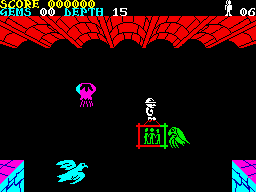
 18
- Underwurlde (Ultimate) 18
- Underwurlde (Ultimate)
'Boing! Time for bed, everyone', said Zebedee once, and Underwurlde
fans knew exactly what he meant. Ultimate's brilliant platform arcade
adventure had only one real difference from the thousands which the
Speccy's played host to. The nasties didn't kill you, they bounced you
around the screen in an attempt (usually successful) to send you
plunging to your death down a mineshaft. The stratospheric level of
frustration made this at the same time the most-loved and most-hated
computer game of its day. If you play it now, you'll see why.
Devilish.
|
|
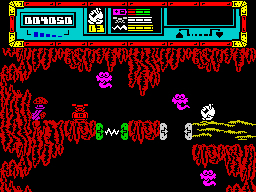
 17
- Starquake (Bubble Bus) 17
- Starquake (Bubble Bus)
And speaking of Ultimate... programmer Steven Crow was never strong on
originality, his games had a habit of looking very much like
'tributes' to earlier Ultimate classics. Nevertheless, his knack for
writing superb software was undisputed. This hybrid of Underwurlde and
Atic Atac was fast and frantic, with a target which was difficult but
attainable. Brimming with playability and addictiveness (thanks
largely to the attributes previously mentioned), Starquake was Steve's
finest hour. To this day many people maintain that it's the Speccy
arcade game's finest hour too. A classic in the truest sense of the
word.
|
|
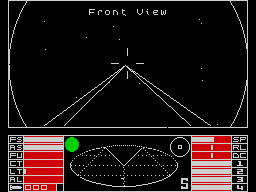
 16
-
Elite
(Firebird) 16
-
Elite
(Firebird)
Were you deadly? The all-time classic space trading and blasting epic,
Elite combined Star Trek with Minder (that's what it boils down to) in
a game for which the word 'legendary' seems like a severe
understatement. Deeper than space itself, Elite created such a believable world
that players immersed themselves into totally, and the sneering
ranking system ('What do you mean, I'm "Harmless"?') added a
compulsion to progress that was, well, incredibly compulsive. It was
big, it was hard, and it was clever. That's good enough for me, matey.
|
|
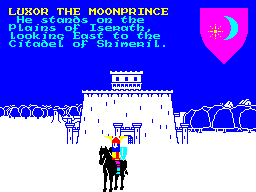
 15
- Lords of Midnight (Beyond) 15
- Lords of Midnight (Beyond)
In the days of 48K, software houses would often make a big issue of
the number of screens contained in their latest game. Companies
boasted of games with 20, then 50, then 100, then 250 levels, but
Beyond stunned everyone. Not surprising really 'cos there were no less
than 32,000 accurately-mapped views in this complex and wonderful
strategy wargame. For the first time you really got the feel of being
lost in a huge land in another world. This overwhelming sense of
atmosphere was pretty spooky and it went a long way to ensuring that
Lords of Midnight was a colossal and deserved success.
|
|
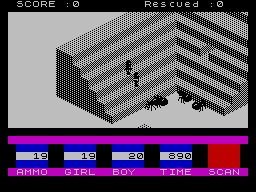
 14
- 3D Ant Attack (Quicksilva) 14
- 3D Ant Attack (Quicksilva)
There's a strong case for calling this the most beautiful game ever to
grace the Speccy. The graphics were made up of simple blocks and the
characters were unremarkable stick men and women. But the stunning
architecture of Antescher, the lost city inhabited by huge ants that
the player had to rescue their girl/boyfriend (no sexism here), was
quite stunning. 'Atmospheric' is a much-overused term - especially in
these Top 100 articles, ahem. But if ever a game deserved the
accolade, it's this one. Completely unique and utterly wonderful, Ant
Attack was one of those games that took the Spectrum a step further
than it had ever been before.
|
|
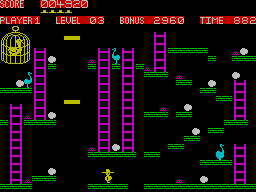
 13
- Chuckie Egg (A & F) 13
- Chuckie Egg (A & F)
Very probably the most-played computer game the world's ever seen, if
you don't count Super Mario Brothers as a computer game, that is.
Chuckie Egg was converted for just about every machine under the sun,
but the Speccy incarnation was the original and best. A
straightforward platform game with the emphasis on speed and
playability, Chuckie Egg rose above its daft title and total lack of
promotion to become the longest-running chart smash until Robocop,
some six years later. If you want to see how thought and care can
transform the most basic concept into a classic, take a look at this.
|
|
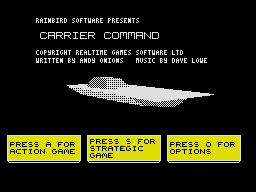
 12
-
Carrier Command (Rainbird) 12
-
Carrier Command (Rainbird)
Now this... this is just silly. For Rainbird to even consider for a
second that this stunning 16-bit epic would ever make a Speccy game
was quite obviously self-delusion of the second highest order.
Luckily, like the bumble bee which can only fly because it doesn't
know that the laws of aerodynamics forbid it, they went ahead and, in
the process, brought one of the most engrossing games ever to the
Spectrum in all it's glory. Absolutely nothing from the original
version was left out, leaving this monster of sea-going strategy and
shoot-'em-up action as the most playable warfare experience ever seen
this side of Davy Jones' Locker.
|
|
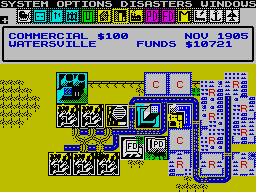
 11
- Sim
City (Infogrames) 11
- Sim
City (Infogrames)
Now this... this is just silly. For Infogrames to even consider for a
second that this stunning 16-bit epic would ever make a Speccy game
was quite obviously self-delusion of the very highest order. Luckily,
like the bumble bee which can only fly because it doesn't know that
the laws of aerodynamics forbid it, they went ahead and, in the
process, brought one of the most compulsive games ever to the Spectrum
in all it's glory. Absolutely nothing from the original version was
left out, leaving this monster of municipal planning and political
manoeuvring the most compelling strategic experience that anyone ever
lost a night's sleep over.
|
|
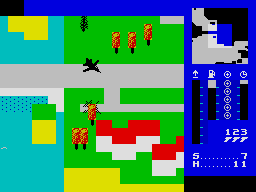
 10
- TLL (Vortex) 10
- TLL (Vortex)
For me, Tornado Low Level (to give it its Sunday name) still
represents the most astonishing technical achievement on the Spectrum
ever. Solid 3D full-colour graphics, scrolling smoothly and swiftly in
eight directions, stunned everyone. Testing gameplay and perfect
playability made it a game worth having in its own right over and
above the sheer 'Gosh, wow'-ness of it all. If some incompetent tells
you your Spec can't handle more than two colours at a time, even in
some poxy 2D arcade shoot-'em-up conversion, show 'em this and watch
them die of shame.
|
|
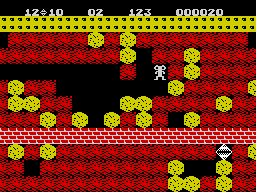
 9
-
Boulderdash 9
-
Boulderdash
(First Star/Front Runner)
Yes, Spec-chums, physics can be fun! Well, it can as long as you're
playing Boulder Dash. The classic underground and diamond-collecting
epic relied heavily on calculating the effects of gravity on piles of
dangerous boulders. Fiendishly-designed levels and extra baddies complicated matters
to a horrendous level. While based on existing concepts, Boulder Dash
transcended its roots and turned out to be one of the most original
games in years. That it's one of that select group to be converted
from the Speccy to the
Game Boy proves the broadness of its appeal.
|
|
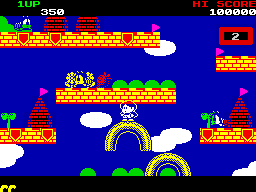
 8
-
Rainbow Islands (Ocean) 8
-
Rainbow Islands (Ocean)
For many (me included), this is the best 16-bit game of all time. The
adorable graphics, lovably naff music (a pocket-calculator version of
Somewhere Over The Rainbow), instinctive gameplay and a level of
hidden depth that would shame the Pacific make it all but the
perfect arcade game. Unfortunately, on the Speccy the graphics are
just a little bit too indistinct for comfort on the later levels,
making it a real bitch to complete in a slightly unfair kind of way,
but that's its only flaw. With keen eyes or a really good
monitor, this is just about the only game you'll ever really need.
|
|
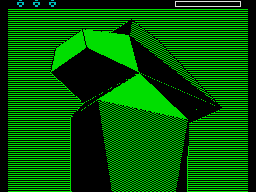
 7
-
The
Sentinel (Firebird) 7
-
The
Sentinel (Firebird)
In direct contrast to Rainbow Islands, The Sentinel is a sombre,
slow-moving game of mental exertion and tactical acumen as the player
struggles to reach the top of a complex 3D landscape while avoiding
the deadly gaze of old Sentinel and his evil minions. How did you
manage it? By absorbing energy from trees and converting it into
boulders to stand on and raise yourself ever higher until you could
absorb the big guy himself and move on to the next of 10,000
landscapes, of course. Twice as weird as it sounds and fifty times as
fun, this is a game no-one with a brain should be without.
|
|
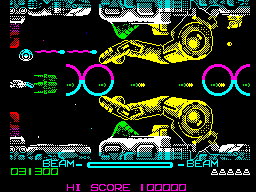
 6
- R-Type
(Activision) 6
- R-Type
(Activision)
We're into the realm of the staggering now, and R-Type is a game which
certainly fits that description. An impossible conversion, the
programmers flicked two fingers at the world and produced a game with
non-stop high-speed frenzied blasting, huge graphics exploding
(literally) with colour, and a near-perfect replication of the arcade
gameplay. The Speccy's finest shoot-'em-up by a mile, indeed almost
certainly the best shoot-'em-up on any 8-bit machine ever. Every time
I see this, I still refuse to believe it's possible. Amazing.
|
|
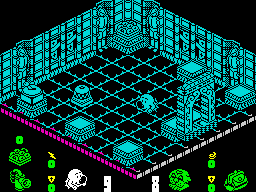
 5
-
Head Over Heels (Ocean) 5
-
Head Over Heels (Ocean)
After Knight Lore, there were a hundred isometric 3D arcade adventure
puzzle games, but this is undeniably the peak of the genre. It's quite
possible that this game represents the peak of the game designer's art
full stop, it was monstrously cute and gorgeous-looking. Head Over
Heels toyed with the player's emotions as he struggled to join up the
two independent heroes, only to have the joy of success cruelly
shattered by another problem which could only be solved by splitting
them up again. Mind-wrenchingly devious but always tantalisingly
solvable, this is so addictive it hurts.
|
|
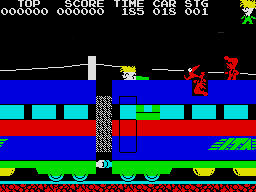
 4
- Stop The Express (Sinclair) 4
- Stop The Express (Sinclair)
Is this the cutest Speccy game ever? I certainly think so. The
Japanese influence of Oriental programmers Hudson Soft shone through
like a beacon. Your gorgeous mop-headed hero swash-buckled his way
across the roof of a speeding train, killing bad guys by throwing
plucked birds at them! The graphics were impossibly bright and lovely
and the gameplay hugely addictive. But the very best thing was the way
that the demo mode consisted of a re-run of your last game in its
entirety. Pure arcade beauty.
|
|
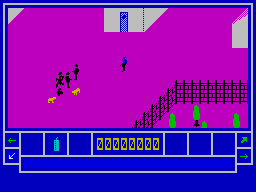
 3
- All Or Nothing (Abbex) 3
- All Or Nothing (Abbex)
Even if you are as old as me you probably won't have heard of this
one. The crude graphics and mostly purple screen ensured that most
gamers gave this a wide berth, which is a shame as it's an unrivalled
classic in the espionage field. Sneaking around an enemy complex,
letting off bombs to distract guard dogs, stealing stuff from deaf
guards' pockets, breaking into locked warehouses to steal important
documents, bribing the enemy with money looted from their fallen
comrades' bodies, every devious trick you ever wanted to try was
catered for in this enormously entertaining piece of software. Too
compelling for words.
|
|
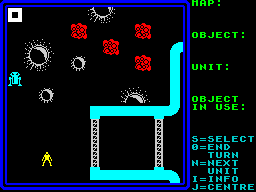
 2
- Rebelstar (Firebird) 2
- Rebelstar (Firebird)
A very close second, I can tell you. Before Julian Gollop's epic,
wargaming was a minority interest characterised by tedious
number-crunching and amateur programming. Then came Rebelstar, turning
it into an experience unrivalled for thrills by all but the most
adrenalin-pumping blaster. The battle for the rebel space station was
fast-moving and violent. But best of all, the incredible glow of
satisfaction you got from beating the thing at the top level was
incomparable. The price of a masterpiece? £1.99. The second best game
in the world ever.
|
|
|
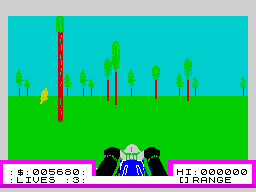
 1
-
Deathchase (Micromega) 1
-
Deathchase (Micromega)
No apologies, no regrets. Y'see, spec-chums, I've been playing
computer games for as long as computer games have existed. I've played
thousands of them, from coin-op games to ZX81 games to Apple Macintosh
games and all points in between. And the simple fact of the matter is
that there isn't one in existence that's as exciting, as gripping, as
tense, or as downright thrilling as this is. Written in 1982 in just
9K of memory, Deathchase puts you on a motorbike in a forest, with no
purpose in life other than to chase other characters on motorbikes and
kill them for bounty money.
Your enemies don't shoot back at you
(not even the the bonus-point tanks and helicopters), there are no
power-ups, no end-of-level bosses, and the only things which can kill
you are the trees of the forest itself. They don't TRY to kill you, of
course, they just stand there, growing leaves and photosynthesising
and doing whatever it is that trees do over the countless millennia,
and wait for you to crash headlong into them at full tilt. And you
will. The inanimate nature of your only enemy gives Deathchase
addictive qualities which are almost unimaginable to anyone who hasn't
played it. Y'see, when you get killed in Deathchase, it's nobody's
fault but your own. The trees don't move, nothing shoots at you to
distract you and you can even slow down or stop to catch your breath.
Basically, there's absolutely no excuse for getting yourself
splattered all over the forest except your own carelessness and
impatience.
Which means, of course, that the next
time you play, you won't make any of those silly mistakes. Will you?
Well, of course you will. The thing is, the game is so utterly simple
(I mean, 'Avoid the trees', it's almost insulting) that you don't see
any reason to slow down, you can't accept that your skills as a games
player aren't equal to the task. So off you go at top speed again,
whizzing through the forest in fine dramatic style until you remember
that you've got enemies to chase. So you swerve after them with your
bullets zipping past just centimetres away, edge just that bit further
over to get them into your sights, and BLAM! Another faceful of bark.
There's more to Deathchase than this,
but not much more (as a wise man once said, more or less). For one
thing there's the sound. Not that there's a lot of it, all you get is
a scary siren effect at the start of each level and a jarring screech
when you collide with one of these ubiquitous giant redwoods. The
result, though, is so effective you wonder why no-one does it more
often. The silence as you whip soundlessly between the trees just
makes the sudden explosion of noise all the more terrifying - this is a
game that'll make you jump off your seat in fright if you play it at
night with the lights off.
And that reminds me - there's night time
too. Every second level of Deathchase is a night level, with the same
number of trees as the previous one but with the light blue sky turned
pitch black. Theoretically it shouldn't make things any harder, but
the atmosphere is so gloomy and oppressive that you find yourself
crashing out of purpose out of sheer subconscious despair. The coming
of dawn (when you finally manage to nail the two bikers) heralds an
increased level of danger, but the relief of being back in daylight is
so great that you almost welcome it.
Finally there are the 'bonuses'. Every
now and again a tank or helicopter cruises slowly across the horizon
from left to right. They don't shoot at you, they don't get in your
way, they don't drop reinforcements for the bad guys, they don't do
you harm in any way. Except that sometimes they're just too much of a
sitting target to pass up, and you deviate from your path for a single
second to bag the juicy points bonus you get for shooting them, and...
BLAM! Time to leave your teethmarks for posterity once more. They
never hurt you, but you'll grow to hate them.
Doesn't sound like much, does it?
Bikes, trees, bonus targets and crashing. (Lots of crashing.) Only two
real controls, hardly any sound, totally basic character square
graphics and gameplay your dog could probably learn. I'm probably
taking rubbish, all those years in front of flickering screens have
probably destroyed my mind. It can't be that good really. So why not
prove me wrong? Why don't you give it a try? What have you got to
lose? Except the rest of your life, that is... |
|





































































































